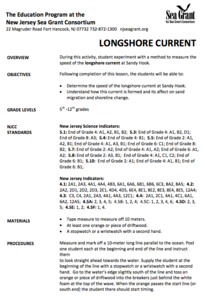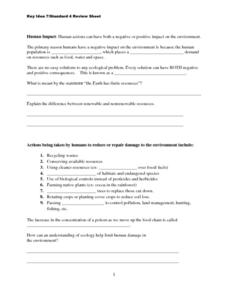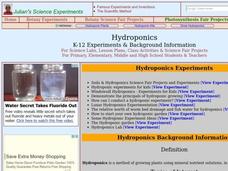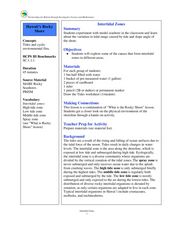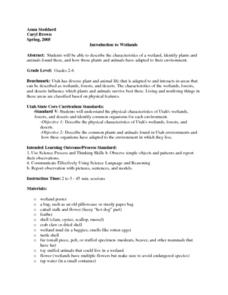Curated OER
Longshore Current
Learners are posted at the beginning and end of a 10-meter long line parallel to the ocean and are instructed to look straight ahead towards the water. The student at the beginning of the line uses a stopwatch, goes to the water's edge...
Curated OER
Bioplastics
Young scholars define bioplastics and identify its uses. In this bioplastics lesson, students compare and contrast styrofoam to starch peanuts after careful examination. Young scholars understand what biodegradeable means.
Curated OER
Nutrition: It's In Your Hands
Fourth graders use this lesson to focus on their health, nutrition and the state of the environment. In groups, they examine the various types of land, water and air pollutants and compare and contrast a food chain with and without a...
Curated OER
Topography of Africa
Students study Africa's diverse landscape and investigate how these features impact the available water supply, food sources, and population distribution of the continent. They compare topographical features and
their affect on each...
Curated OER
Pollution and Marine Life
In this pollution and marine life worksheet, students use 9 given terms related to types of pollution and ocean food chains to complete sentences. Students number the effects of human sewage and soil runoff that harm ocean organisms in...
Curated OER
Design a Plankton
Students explore animal and plant adaptation. In this ecosystems science lesson, students view websites to gain information about plankton and its interdependence within ecosystems. Students identify ways in which plankton...
Curated OER
Explore Your Natural Habitat
Students identify habitats and understand why they are important to our environment. In this environmental lesson plan students design their own habitat, observe and record data on the impact their habitat has on the environment.
Curated OER
Temperature in the Sun or Shade of the Desert
Third graders use thermometers to measure the air temperature in several
places around the school and then return to the classroom to record the data. They create a bar graph and discuss their findings about the air temperature in the...
Curated OER
Food and Kitchen Safety Lab
Learners review kitchen management, safety, and sanitation rules, and practice applying safety and sanitation rules in kitchen lab by preparing chicken stir-fry over rice while maintaining safe working environment. Students then complete...
Curated OER
More Acid-Base Indicators
Students explore acids, bases, and indicators. They use turmeric solution, phenolphthalein, and goldenrod paper to determine the acidity and basicity of a variety of common household substances. A worksheet is included to record test...
Curated OER
A Fish Tale
Learners investigate the lives of fish. In this biology lesson plan, students demonstrate how fish cells respond to fresh and salty water, determine the age of a fish and if temperature effects the movement of a fish's operculum (gill...
Curated OER
Standard 4 Review-Human Impact
In this human impact on the environment worksheet, students fill in the blanks to complete sentences about how humans have negatively affected the environment. They complete sentences about the actions taken to reduce and repair the...
Curated OER
Science in the Garden
Students examine soil from their local environment. In this garden lesson, students recognize the importance of soil in the garden. Students explore the contents of the local soil.
Curated OER
A Fish Tale
Students conduct an experiment. In this fish lesson, students discover how fish cells respond to fresh and salty water and if temperature effect the movement of a fish's gills. Students also identify the characteristics of a fish.
Curated OER
Kansas Ponds, Lakes & Reservoirs
Students compare the ponds, lakes, and reservoirs of Kansas. In this geography lesson, students use Google Earth to research the different ponds, lakes, and reservoirs in Kansas. Students will discover that many of the bodies...
Curated OER
Hydroponics
Students examine how to grow plants using a hydroponic system. For this hydroponics lesson students identify the advantages and disadvantages of growing plants hydrologically.
Curated OER
Intertidal Zones
Students explore intertidal zones. In this intertidal zones lesson plan, students work in small groups and use ready-made materials to create a model of intertidal zones. Resources are provided.
Curated OER
Eutrophication Lab
Middle schoolers examine the effects of detergents and fertilizers on aquatic life and describe algae. Students define the term eutrophication as the process by which a body of water, such as a pond, lake, stream, or river, has a sudden...
Curated OER
Introduction to Wetlands
Students describe the characteristics of a wetland, identify plants and animals found there, and how those plants and animals have adapted to their environment. They visit stations, view a video, and complete a KWL about the wetlands.
Curated OER
Marine Environmental Geology
Students take this course as an introduction to the aspects of marine geology and oceanography that affect the environment and marine resources. Topics include estuarine oceanography and sediments, eutrophication of coastal waters,...
Curated OER
Bird Bodies
Students read about and explore the different types of birds. They discuss how all birds are alike and what makes some different from the others. They experiment picking up "food items" using different tools that represent different...
Curated OER
The Hudson's Ups and Downs
Fifth graders practice interpreting line graphs of the Hudson River water levels to assess the tides and tidal cycles in the estuary. They explore how weather can affect water levels and tides and observe that high tides and low tides...
Curated OER
The Effects of Temperature Variations on the Heartbeat Rate of Daphnia
Students use DigiScope technology to investigate Daphinia, popularly known as water fleas. They design, conduct, and report on an experiment to determine the effects of varying water temperatures on the heartbeat rate of Daphnia.
Curated OER
Katrina Case Study
Students explore the impact natural events have on the environment, specifically the wetlands. They view a video about the impact of Hurricane Katrina on the Mississippi Delta and answer discussion questions.
